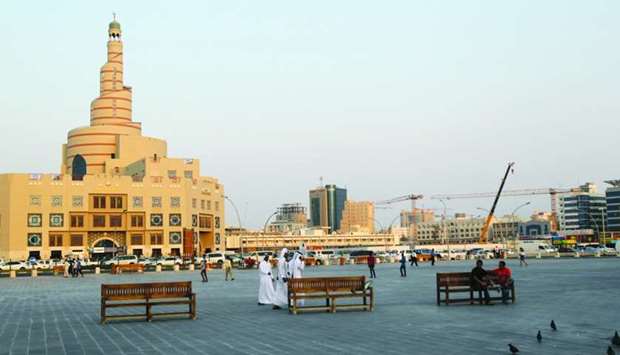Qatar’s performance is better off than its neighbours because of “successful economic” diversification, through development of large-scale projects, Lloyds Bank has said in an economic overview.
The country weathered the diplomatic rift with some other Gulf countries by finding new import and export routes, with its growth rate estimated to have reached 1.5% in 2018; although the GDP has only increased by 0.1% in 2019, Lloyds Bank noted.
According to the updated IMF forecasts (April 2020), due to the outbreak of the Covid-19, GDP growth is expected to fall to -4.3% in 2020 and pick up to 5% in 2021, subject to the post-pandemic global economic recovery, conclusion of an expected boom in the services sector, ahead of the FIFA 2022 World Cup.
Qatar is the world's leading exporter of liquefied natural gas and holds the third largest gas reserves in the world (estimated at 16% of the global total). The country’s economy is thus heavily concentrated in the gas industry, which represents two-thirds of its GDP and almost 80% of export earnings.
The commissioning of Barzan natural gas facility, Lloyds Bank said “could support” domestic gas production and “contribute positively” to growth.
In the medium term, the expansion of North Field gas projects is expected to be completed by 2024, further boosting gas output.
Qatar has been implementing an economic diversification programme to lower its dependency on the hydrocarbon sector, and in December 2018 the country announced it would leave Opec in January 2019 to focus its efforts on natural gas.
New projects are planned in infrastructure and telecommunications, and various construction projects are in progress in preparation for the World Cup in 2022. Inflation was estimated to have fallen to -0.6% last year from 0.2% in 2018. IMF estimated inflation to decrease to -1.2% in 2020 and increase to 2.4% in 2021 in its latest World Economic Outlook of April 2020; indeed, Qatar has postponed plans to introduce a value added tax (VAT) to 2021 the earliest, suggesting “inflation will continue to remain weak” this year.
Qatar's economy started to grow faster after the first quarter of 2019 as government spending rose, particularly with regards to wages in the public sector, the report said.
This, Lloyds Bank said helped boost the economy later in the year, which had showed signs of a “slowdown” as most major infrastructure and construction projects in relation to the World Cup came to completion. Nonetheless, general government debt was also estimated to have grown to 53.2% of GDP in 2019, from 48.6% a year earlier, as the country continued to borrow in international markets.
However, IMF anticipates a debt reduction in the coming years, 48% in 2020 and 43.1% in 2021, Lloyds Bank noted.
According to the updated IMF forecasts (April 2020), due to the outbreak of the Covid-19, GDP growth is expected to fall to -4.3% in 2020 and pick up to 5% in 2021, subject to the post-pandemic global economic recovery, conclusion of an expected boom in the services sector, ahead of the FIFA 2022 World Cup.
Qatar is the world's leading exporter of liquefied natural gas and holds the third largest gas reserves in the world (estimated at 16% of the global total). The country’s economy is thus heavily concentrated in the gas industry, which represents two-thirds of its GDP and almost 80% of export earnings.
The commissioning of Barzan natural gas facility, Lloyds Bank said “could support” domestic gas production and “contribute positively” to growth.
In the medium term, the expansion of North Field gas projects is expected to be completed by 2024, further boosting gas output.
Qatar has been implementing an economic diversification programme to lower its dependency on the hydrocarbon sector, and in December 2018 the country announced it would leave Opec in January 2019 to focus its efforts on natural gas.
New projects are planned in infrastructure and telecommunications, and various construction projects are in progress in preparation for the World Cup in 2022. Inflation was estimated to have fallen to -0.6% last year from 0.2% in 2018. IMF estimated inflation to decrease to -1.2% in 2020 and increase to 2.4% in 2021 in its latest World Economic Outlook of April 2020; indeed, Qatar has postponed plans to introduce a value added tax (VAT) to 2021 the earliest, suggesting “inflation will continue to remain weak” this year.
Qatar's economy started to grow faster after the first quarter of 2019 as government spending rose, particularly with regards to wages in the public sector, the report said.
This, Lloyds Bank said helped boost the economy later in the year, which had showed signs of a “slowdown” as most major infrastructure and construction projects in relation to the World Cup came to completion. Nonetheless, general government debt was also estimated to have grown to 53.2% of GDP in 2019, from 48.6% a year earlier, as the country continued to borrow in international markets.
However, IMF anticipates a debt reduction in the coming years, 48% in 2020 and 43.1% in 2021, Lloyds Bank noted.


